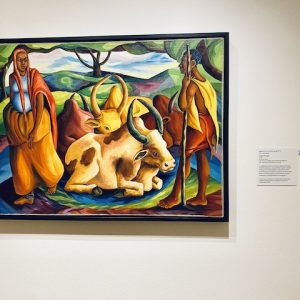A few weeks ago, I had the opportunity to visit the remarkable African Modernism in America, 1947- 67 exhibition, which was showcasing at The Phillips Collection Museum in Washington, DC. This delightful exhibition, co-curated by Perrin Lanthrop, Jamaal Sheats, and Nikoo Payder, presented a collection of works donated to Fisk University by the Harmon Foundation. The fourth and final installation of this traveling exhibition is currently showing at The Taft Museum of Art in Cincinnati and is definitely worth a visit.
With over fifty artists, this exhibition has generated a lot of buzz and praise among art enthusiasts for highlighting aspects of African art history, a subject that is often overlooked. During the panel discussion to close out the exhibition, art historians Chika Keke Agulu and Salam Hassan complimented the curators, noting, “it is very rare to see the range and scope of the works we see here.” They explained that within an African Studies framework, these artworks capture many of the issues that were taking place at the time. For example, looking at modernism as separation from European influence. At the time, many of the intellectuals were concerned with re-asserting an African identity separate from the European experience which had colonized Africa. Many of themes we see in the art and the literature center around ideas of self-governance, socio-economic development and engagement with the global north.
These issues resonated deeply with African artists. As is evident in the exhibitions, many of the artists emphasized African customs and culture. For example, Sam Joseph Ntiro’s poignant piece, Men Taking Banana Beer to Bride by Night, which is one of the earliest works to be acquired by the Museum of Modern Art. Cattle people, by Manyolo Estella Betty, is another piece that gives us insight into traditional family life in Uganda. The overall impression being that Africa had a rich tapestry of customs separate from those imposed by European rule. And in order to engage in cross-cultural conversations these topics would have to be acknowledged.
If there is one theme that threads the exhibition together, it’s the idea of collaboration. Throughout the exhibition we see the role philanthropic organizations such as the Harmon Foundation, Merton D. Simpson Gallery, David Driskell, HBCUs like Howard, Fisk, Hampton and their illustrious alumni play in creating access for African Artists in America. These organizations facilitated cross-cultural exchange through various means such as funding, residencies, and solo exhibitions. Ben Enwonwu, for instance, is the first African artist to hold a solo show in America. He does so with the help of David Driskell at Howard University. Beyond academia, African American Gallery owner Merton D. Simpson and his namesake gallery in New York play a pivotal role introducing artist to a wider American audience.
What stands out in this exhibition is the way art becomes a true icebreaker for global engagement. As African countries gain their independence there is tremendous interest in the continent. Of course, there was foreign policy objectives on the part of America to engage Africa as a way to thwart the spread of communism but we see that art is at the heart of this engagement. Artists, writers and politicians become some of the intellectuals that can explain the African condition. One artists that really stands out is South African artist, Peter Clarke whose works capture the isolation and suffocating conditions of apartheid south Africa. His elongated figures and colorful pieces show the resiliency of the human spirit under desperate conditions.This is something many African American audience could relate to given segregation and the push for civil rights. Overall, this was a remarkable exhibition that brought these hidden histories to the forefront. I hope the showcase inspires researchers and institutions alike to continue bringing these histories and artworks to a wider audience.




